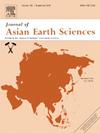Origin of the recently-discovered Zhongpai Co-rich pyrite deposit in the Lanping-Simao Basin, southwest China: Constraints of trace elements and S isotopes of pyrite and U-Pb ages of monazite
IF 2.7
3区 地球科学
Q2 GEOSCIENCES, MULTIDISCIPLINARY
引用次数: 0
Abstract
Hydrothermal deposits are important sources of metal Co, but their origins are poorly understood. Although some hydrothermal Cu deposits, such as the Baiyangping, Changjie and Jinman deposits, in the Lanping-Simao Basin, Yunnan Province, SW China, are known to have considerable amounts of Co, the concentrations of Co in these deposits are generally low (usually < 0.1 wt%) and studies of Co enrichment are few in literature. An exception is the recently discovered Zhongpai pyrite deposit which contains high-grade Co ores with up to 1 wt% Co (average Co ore grade of 0.46 wt%). The Co-rich pyrite ores are structurally controlled and are stratiform or lenticular bodies in mudstone and sandstone that are intercalated with limestone of the Middle Jurassic Huakaizuo Formation. In this paper, we present in-situ trace elements and S isotopes of pyrite and U-Pb ages of monazite, to constrain the ore-forming process and geodynamic setting of this deposit. The ores are mainly composed of pyrite (∼90 vol%), with lesser amounts of chalcopyrite and other minerals. The mineral paragenesis can be divided into three generations: pyrite (Py1)-monazite-quartz-bitumen, pyrite (Py2)-chalcopyrite-tetrahedrite-arsenopyrite, and pyrite (Py3)-calcite-ankerite-quartz. The U-Pb age of hydrothermal monazite is 12.7 ± 0.4 Ma. Py1 contains Co of up to 63600 ppm with an average of 19200 ppm. No Co minerals are identified in all three generations and Co is mainly in pyrite due to the isomorphic substitution Co2+ ↔ Fe2+. Pyrite of three generations has Co/Ni ratios from 0.4 to 22.4 consistent with the hydrothermal origin. In addition, the Co/Ni ratios and Se contents of Py1 are higher than those of Py2 and Py3, whereas the trends of the As contents are the opposite. This implies that the early Co-rich fluids formed under high temperatures. The δ34S values of pyrite from all three generations range from + 2.6 ‰ to + 9.6 ‰, indicating sulfur was derived mainly from evaporitic sulfate within the ore-bearing strata. In summary, the Co-rich pyrite ores formed during the late middle Miocene and constrain the timing of mineralization in the Sanjiang metallogenic belt, SW China. The Co enrichment was jointly controlled by geological setting and ore formation physicochemical condition.
求助全文
约1分钟内获得全文
求助全文
来源期刊

Journal of Asian Earth Sciences
地学-地球科学综合
CiteScore
5.90
自引率
10.00%
发文量
324
审稿时长
71 days
期刊介绍:
Journal of Asian Earth Sciences has an open access mirror journal Journal of Asian Earth Sciences: X, sharing the same aims and scope, editorial team, submission system and rigorous peer review.
The Journal of Asian Earth Sciences is an international interdisciplinary journal devoted to all aspects of research related to the solid Earth Sciences of Asia. The Journal publishes high quality, peer-reviewed scientific papers on the regional geology, tectonics, geochemistry and geophysics of Asia. It will be devoted primarily to research papers but short communications relating to new developments of broad interest, reviews and book reviews will also be included. Papers must have international appeal and should present work of more than local significance.
The scope includes deep processes of the Asian continent and its adjacent oceans; seismology and earthquakes; orogeny, magmatism, metamorphism and volcanism; growth, deformation and destruction of the Asian crust; crust-mantle interaction; evolution of life (early life, biostratigraphy, biogeography and mass-extinction); fluids, fluxes and reservoirs of mineral and energy resources; surface processes (weathering, erosion, transport and deposition of sediments) and resulting geomorphology; and the response of the Earth to global climate change as viewed within the Asian continent and surrounding oceans.
 求助内容:
求助内容: 应助结果提醒方式:
应助结果提醒方式:


